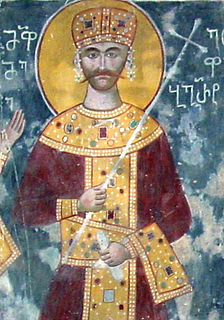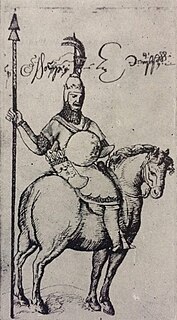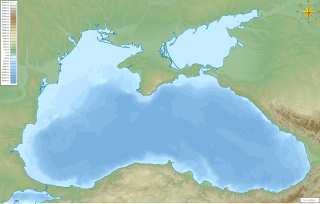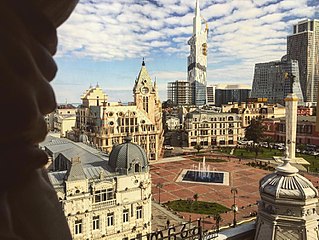
Bagrat III (1495-1565), of the Bagrationi dynasty, was a King of Imereti from April 1, 1510, to 1565. He succeeded upon the death of his father, Alexander II, and faced repeated assaults from the Ottoman Turks as well as the conflicts with his ostensible vassal princes of Mingrelia, Guria, and Abkhazia who were frequently joining the enemy.
Giorgi III Gurieli, of the Georgian House of Gurieli, was Prince of Guria from 1669 to 1684 and King of Imereti from 1681 to 1683. He was energetically involved in civil wars in western Georgian polities, which he sought to bring under his sway. He was killed in battle while trying to recover the lost throne of Imereti.

Mamia III Gurieli, also known as Mamia the Great Gurieli or the Black Gurieli, of the western Georgian House of Gurieli, was Prince of Guria from 1689 to 1714. Involved in civil wars plaguing western Georgia, he became King of Imereti three times in the years of 1701, 1711–1712, and 1713–1714. After his first reign as king for a year in 1701, he abdicated the throne of Imereti, being unable to tolerate the influence of his father-in-law Giorgi Abashidze. Subsequent periods of his royal career was the result of a feud with Giorgi VII of Imereti. Mamia died while still sitting on the throne of Imereti, which then reverted to his rival Giorgi VII.
Giorgi IV Gurieli, of the House of Gurieli, was Prince of Guria from 1711 to 1726, and a king of Imereti in western Georgia in 1716. He was installed as regent of Guria by his father, Mamia III Gurieli, then the king of Imereti, in 1712. In 1716, he seized the crown of Imereti, but was forced to abandon the enterprise later that year. Returning to Guria, his rule was challenged by a faction of local nobility, which included his mother Elene and brother Kaikhosro III Gurieli. He was finally able to crush the opposition after making peace with Bezhan Dadiani, Prince of Mingrelia.
The Battle of Sokhoista was fought between the Ottoman and Georgian armies at the Sokhoista field in what is now northeastern Turkey in 1545. It was the last attempt of the separate Georgian dynasts to fight as one unit against the Ottoman expansion, but ended in their decisive defeat. This might be the same battle as mentioned by Rüstem Pasha to have been fought at nearby Zivin.
Giorgi III Dadiani was Prince of Mingrelia, of the House of Dadiani, from 1572 to 1573 and again from 1578 until his death. He was a son and successor of Levan I Dadiani.
Mamia IV Dadiani was Prince of Mingrelia, of the House of Dadiani, from 1573 to 1578 and again from 1582 until his death. He was a younger son of Levan I Dadiani.

Manuchar I Dadiani was Prince of Mingrelia, of the House of Dadiani, from 1590 until his death. A younger son of Levan I Dadiani, he succeeded on the death of his elder brother, Mamia IV Dadiani.
Kakhaber II Gurieli, of the House of Gurieli, was eristavi ("duke") of Guria from c. 1469 until his death in 1483.
Vakhtang I Gurieli, of the House of Gurieli, was Prince of Guria from 1583 to 1587. He ruled Guria, a small state in southwestern Georgia, as a client of Mamia IV Dadiani, Prince of Mingrelia, who had deposed Giorgi II Gurieli. Vakhtang was one of the sponsors of the Shemokmedi Monastery, Guria's principal cathedral.
Mamia II Gurieli, of the House of Gurieli, was Prince of Guria from 1600 until his death at the hands of his own son Simon in 1625. Mamia's rule over his small principality, located in southwest Georgia, saw efforts to rebuff encroachments of the Ottoman Empire, with which he was forced to make peace in 1614, conceding the loss of territories and placing Guria under the obligation of paying tribute.
Mamia IV Gurieli, of the western Georgian House of Gurieli, was Prince of Guria from 1726 to 1756 and again from 1758 to 1765 and from 1771 to 1776. Intermissions of his rule was the result of Mamia's rivalry with his younger brother, Giorgi V Gurieli, and complex political situation in the region, including the Ottoman encroachments and efforts by the kings of Imereti to bring western Georgian polities under their supreme authority.
Giorgi V Gurieli, of the western Georgian House of Gurieli, was Prince of Guria from 1756 to 1758 and again from 1765 to 1771 and from 1776 to 1788.
The Ottoman invasion of Guria was remarkable event of Ottoman Empire against Principality of Guria, which resulted by occupation of the Chaneti (Lazistan) and Adjara; maritime settlements of Gonio and Batumi, in 1547.











